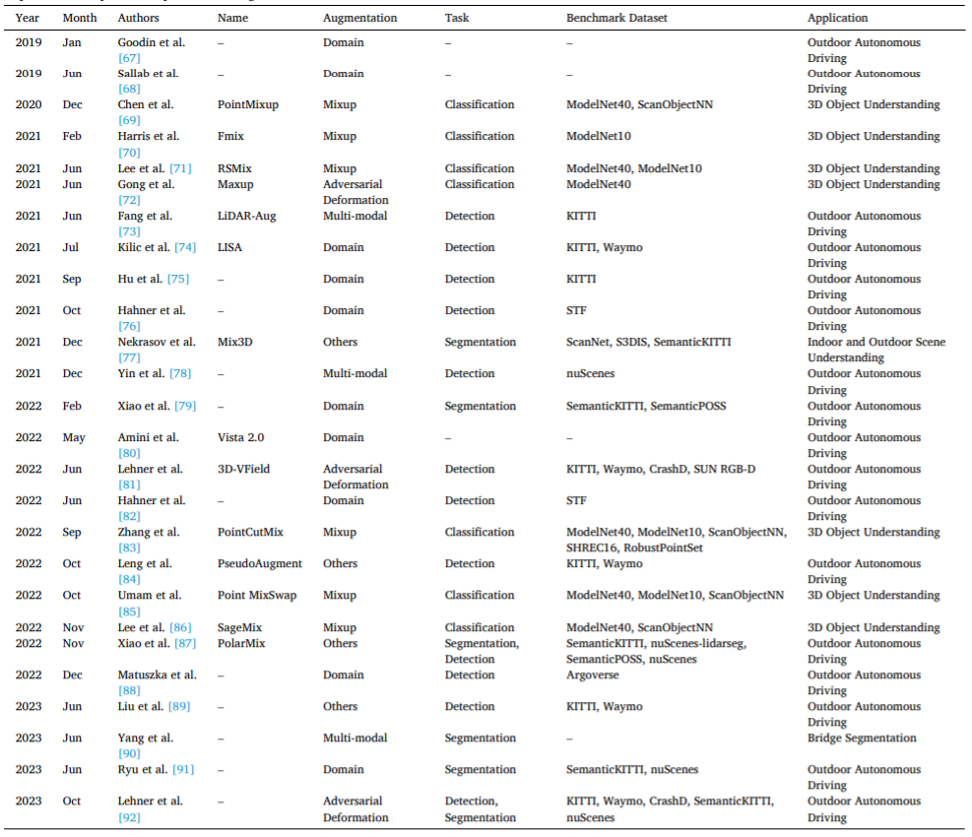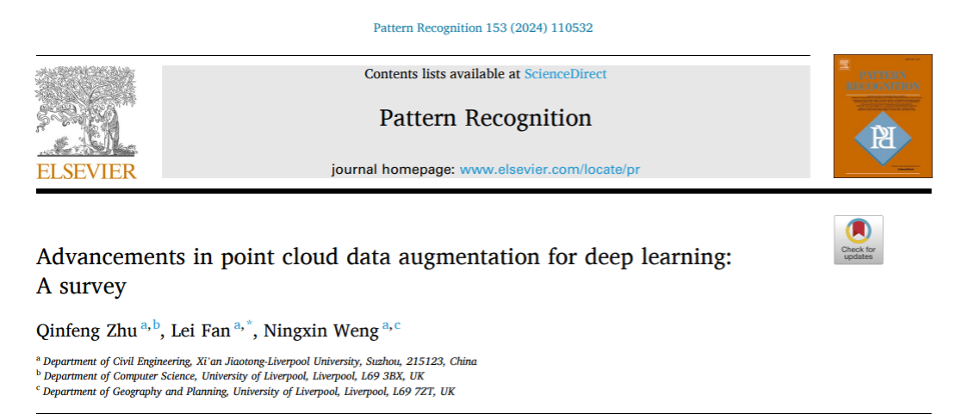The AIxiv column is a column where this site publishes academic and technical content. In the past few years, the AIxiv column of this site has received more than 2,000 reports, covering top laboratories from major universities and companies around the world, effectively promoting academic exchanges and dissemination. If you have excellent work that you want to share, please feel free to contribute or contact us for reporting. Submission email: liyazhou@jiqizhixin.com; zhaoyunfeng@jiqizhixin.com
##The first author of this paper, Zhu Qinfeng, is from Xi'an Jiaotong-Liverpool University A first-year PhD student jointly trained with the University of Liverpool, whose supervisor is Associate Professor Fan Lei. His main research directions are semantic segmentation, multi-modal information fusion, 3D vision, hyperspectral images and data enhancement. This research group is recruiting 24/25-level doctoral students. Email inquiries are welcome. Email: qinfeng.zhu21@student.xjtlu.edu.cnHomepage: https://zhuqinfeng1999.github.io/This article is a review of the latest review paper published in Pattern Recognition 2024, the top journal in the field of pattern recognition: "Advancements in Point Cloud Data Augmentation for Deep Learning: A Survey" Interpretation.
This paper was completed by Zhu Qinfeng, Fan Lei and Weng Ningxin of Xi'an Jiaotong-Liverpool University.
This review comprehensively summarizes the related research work of
point cloud data enhancement for the first time. # Deep learning has become one of the mainstream and effective methods for point cloud analysis tasks such as detection, segmentation and classification. To reduce overfitting during training deep learning models, and especially to improve model performance when the amount or diversity of training data is limited, data augmentation is often key. Although various point cloud data augmentation methods have been widely used in different point cloud processing tasks, no systematic review or discussion of these methods has been published yet.
Therefore, this paper investigates these methods and categorizes them into
a classification framework that contains basic and specific point cloud data enhancement methods. Through a comprehensive evaluation of these enhancement methods, this paper identifies their potential and limitations, providing a useful reference for selecting appropriate enhancement methods. In addition, this article explores
potential directions for future research. This survey helps provide a comprehensive overview of current research on point cloud data augmentation and promote its wider application and development. Free Access: https://authors.elsevier.com/c/1j3TW77nKoLGM
arXiv: https://arxiv.org/pdf/2308.12113
Author home .
Point cloud data enhancementIn the field of deep learning , data augmentation is often used when the available training data set is limited. This involves performing a specific series of operations to modify or extend the original data, thereby increasing the size and diversity of the data set.
Since high-quality augmented data sets help improve the robustness of the network, enhance generalization capabilities, and reduce overfitting, when training a deep learning network, the data Augmentation is almost always considered the ideal option. A comprehensive development has been observed in the field of image data enhancement and text data enhancement.
In numerous recently published research papers on point cloud processing tasks, researchers have explored various methods of enhancing point cloud data. The wide range of these methods creates challenges for researchers in selecting appropriate methods. Therefore, it is of great value to systematically investigate these methods and classify them into different groups.
This paper presents a comprehensive survey on point cloud data augmentation methods.
Based on our survey, we propose a classification system for these enhancement methods, as shown in Figure 1.
Enhancement methods can be divided into two main categories: basic point cloud enhancement and specific point cloud enhancement, which is similar to the typical classification methods of image enhancement.Basic point cloud enhancement refers to those methods that are simple in concept and universal in different tasks and application environments. This is achieved through them Extensive use in combination with other methods is demonstrated in the survey literature. Specific point cloud enhancement refers to methods usually developed to solve specific challenges or respond to specific application environments. In most cases, specific point cloud enhancements are computationally more complex than base enhancements, depending on the implementation details of the enhancement method. The subcategories in our proposed classification system represent a summary of various methods that have been used for point cloud data enhancement in the literature, or have the potential to be used for point cloud data enhancement. The main contributions of this review are as follows:
- This is the first comprehensive survey A review of point cloud data enhancement methods, covering the latest progress in point cloud data enhancement. Based on the characteristics of the enhancement operation, we propose a classification system of point cloud data enhancement methods.
- This study summarizes various point cloud data enhancement methods, discusses their applications in typical point cloud processing tasks such as detection, segmentation, and classification, and provides guidance for future Suggestions are provided for potential research.
Basic point cloud enhancementaffine transformation involves Transformation to affine space that preserves collinearity and distance scaling. In image data enhancement, commonly used affine transformation methods include scaling, translation, rotation, flipping and shearing. Likewise, affine transformations can also be applied to point cloud data augmentation. Typical methods include translation, rotation, flipping, and scaling, and these methods have been widely used to generate additional new training data. These operations can be applied to the entire point cloud dataset, or to selected instances in the point cloud data using specific strategies (instances refer to items such as Figure 2( a) a semantic object such as the vehicle shown), or applied to a specific part of the selected instance. #However, data enhanced by affine transformation may face problems of information loss or unreasonable semantics. The specific operations and discussion of these affine transformations are detailed in the paper. ## to c) rotate the vehicle, (d) scale the vehicle, (e) flip the scene. Discard enhancement refers to discarding some data points in the point cloud data, as shown in Figure 3. The selection of removal points is determined by the specific strategy. The discarded points can be part of the entire point cloud data or randomly selected points in the scene. Dropout augmentation helps deep learning models become more robust to missing or incomplete data representing occluded or partially visible scenes. # It also prevents deep learning models from becoming too dependent on specific data points in the training dataset. However, losing excessive or critical point cloud information may lead to unrealistic representations of real-world objects in the training data and affect the training of deep learning models. Various methods and discussions based on dropout enhancement are detailed in the paper.

## 图 3. Through the enhancement point enhancement example: (a) the original point cloud data, (b) randomly discard the enhancement point cloud, (c) Discarded portion of the enhanced point cloud. Jitter refers to applying small perturbations or noise to the position of a single point in the point cloud, as shown in Figure 4. Various methods and discussions based on jitter enhancement are detailed in the paper.
 图4.抖动增强示例:(a)原始点云数据,(b)抖动增强的点云数据。在场景级的点云数据集中,例如户外自动驾驶场景,标注的实例通常是有限的。在这种情况下,GT-sampling成为一种简单而有效的数据增强方法。GT-sampling是指将带有标签的实例添加到训练数据集中的操作,如图5所示,标记的GT实例来自同一训练数据集或其他数据集。GT-sampling通常适用于场景级点云数据集,而通常不考虑实例级点云数据集,如ShapeNet。基于GT-sampling增强的各种方法和讨论详见论文。 图5.(a)语义合理的GT-sampling,添加的车辆在红框中。(b) 语义不合理的GT-sampling,一辆车在建筑物墙体内,另一辆在树木中。除此以外,本文还介绍了应用于基础点云数据增强方法的策略,如Patch-based策略,和自动优化策略(见图6)。本文对典型的基础点云增强方法进行了汇总,如表1所示。
图4.抖动增强示例:(a)原始点云数据,(b)抖动增强的点云数据。在场景级的点云数据集中,例如户外自动驾驶场景,标注的实例通常是有限的。在这种情况下,GT-sampling成为一种简单而有效的数据增强方法。GT-sampling是指将带有标签的实例添加到训练数据集中的操作,如图5所示,标记的GT实例来自同一训练数据集或其他数据集。GT-sampling通常适用于场景级点云数据集,而通常不考虑实例级点云数据集,如ShapeNet。基于GT-sampling增强的各种方法和讨论详见论文。 图5.(a)语义合理的GT-sampling,添加的车辆在红框中。(b) 语义不合理的GT-sampling,一辆车在建筑物墙体内,另一辆在树木中。除此以外,本文还介绍了应用于基础点云数据增强方法的策略,如Patch-based策略,和自动优化策略(见图6)。本文对典型的基础点云增强方法进行了汇总,如表1所示。


特定点云增强方法通常旨在解决特定的挑战或应用场景。特定点云增强包括:Mixup增强,域增强,对抗性变形增强,上采样增强,补全增强,生成增强,多模态增强和其他。这些特定增强方法的具体定义以及讨论详见文中。表2概述了具有代表性的特定增强方法的发展,提供了各种信息。
需要注意的是,目前一些对抗性变形、上采样、补全和生成技术并没有直接应用到点云数据增强中,如表3所示。为了对特定方法进行全面的分类,本文还包括了这些潜在的方法并对其进行了讨论。
论文中对点云数据增强方法的适用任务以及场景进行了详细的讨论,并指出了点云数据增强在一致性学习中的作用,如图7所示。
图7.(a)常规的深度学习训练,将原始数据和增强数据发送到深度学习网络进行训练,得到训练后的模型;(b)一致性学习,通过各种增强方法对输入点云数据进行变换,生成多个增强变量,然后将其馈送到多个网络进行一致性学习,在训练期间做出一致的预测。表4对进行数据增强前后进行定量评估的文献进行了整理,展示了数据增强的效果。作为比较各种增强方法的另一部分,附录中(详见论文)还概述了使用增强点云数据的下游任务的定量性能,以及这些任务中采用的增强方法。
研究团队针对该领域,指出了进一步研究的九点可能的方向:
-
研究人员没有充分研究进行点云数据增强的对抗性变形、上采样、补全和生成。鉴于GAN和扩散模型的进步,这些模型可用于生成现实和多样化的点云实例。未来的研究应该在特定点云处理任务的基准数据集上评估这些方法,以评估它们作为增强技术的有效性。
-
目前,很少有研究针对不同的点云处理任务,使用一致的基线网络和数据集来评估点云数据增强方法的性能。这样的评估将增强我们对不同增强方法性能的理解。因此,未来的研究工作可能侧重于建立新的方法、指标和/或数据集,以评估点云数据增强方法的有效性及其对深度学习模型性能的影响。
-
当应用于大规模点云数据集时,某些特定增强方法可能会导致计算成本高昂。未来的工作可以集中在开发有效的算法,在计算成本和增强效率之间进行权衡。此外,一些特定点云增强方法相对复杂,难以复现。建议开发即插即用方法,促进其广泛采用。
-
对于点云数据增强,缺乏普遍接受的基本增强操作组合。因此,未来的工作需要建立一个标准协议,在不牺牲增强效率的情况下,为不同的应用领域、任务和/或数据集选择增强操作。
-
通过增强生成的多个点云变体会影响一致性学习的有效性。目前,据我们所知,一致性学习中只使用了基本的增强方法。探索特定点云增强方法,如对抗变形和生成增强,为提高一致性学习的有效性提供了一种有趣的方法,被认为是一个有价值的未来研究方向。
-
目前,将基础点云增强方法与特定点云增强方法相结合的研究有限。这样的组合有可能进一步增加数据增强的多功能性,值得未来的研究。
-
增强需要真实地模拟点云数据的变化,如物体大小、位置、方向、外观和环境的变化,以确保模拟数据与现实世界的情况保持一致,并保持语义正确。未来的研究可以着眼于标准化各种增强范围,以适应特定的应用场景。
-
某些应用,如目标检测,可能涉及场景中的动态物体。在动态环境中捕获的点云可能需要考虑物体时间变化的特定增强策略。例如,可以设计运动物体的特定轨迹,这可以通过一组组合增强操作来实现,例如平移,旋转和丢弃。
-
ViT在简单组合基本操作的情况下,在分割和分类任务上也取得了较强的性能。当与最先进的ViT作为骨干网络集成时,探索增强方法的性能将是有意义的。
[1] Qinfeng Zhu , Lei Fan , Ningxin Weng , Advancements in PointCloud Data Augmentation for Deep Learning: A Survey, Pattern Recognition (2024), doi:https://doi.org/10.1016/j.patcog.2024.110532The above is the detailed content of XJTLU and the University of Liverpool propose: the first comprehensive review of point cloud data enhancement. For more information, please follow other related articles on the PHP Chinese website!


















